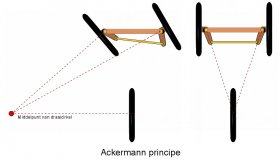Nieuws over de Mango 2014
Gepubliceerd op 23 oktober 2014 09:29, bijgewerkt op 23 oktober 2014 09:41
(2711 keer bekeken) 3![]()
Harry doet in zijn blog verslag van de verbeteringen aan de Mango
Harry, Sinner Bikes, heeft de afgelopen twee jaren niet stil gezeten met de ontwikkeling van de Mango. Dat hebben we bij de races al gezien: met, tot nu toe, ongekende gemiddelde snelheden met de Mango zijn haalbaar.
Nu is dat niet alleen op de conto van Harry's conditie te schuiven. Dat hij wat verder van zijn arbeidsplaats woont dan voorheen, heeft er wel wat mee te maken.
Maar ook de verbeteringen aan de Mango spelen enorm mee. En dat zonder de praktische eigenschappen te verwaarlozen. Want de bochtvaardigheden (de Mango was de enige velomobiel die bij de LEL [url=]de bocht kon halen[/url] zonder hulp van de keerders) en carrosseriestijfheid (beiden nu nog beter) en dit zonder dat het comfort al te veel verwaarloosd wordt.
En dat de meeste van deze verbeteringen ook nog eens beschikbaar komen voor de 'oudere Mango's', als upgradepakket, is wel een heel groot pluspunt.
Al bekende verbeteringen: staartpunt (nog steeds alleen voor de Sport/Classic), een veerpoot met elastomeer, en aerotop. Alsook de al bekende toer/racekap.
De in het verhaal genoemde 'scrub radius' (Engels) of 'Lenkrollradius' (Duits) of schuurstraal, bij het Ackermann principe (ook hier te vinden), is als volgt te zien: de afstand/straal van een denkbeeldige verlengde lijn, de hartlijn, van de stuurstangas naar het midden van het loopvlak van de band, waar deze theoretisch samenkomen. Als deze precies door het midden van het loopvlak van de band loopt, is deze straal 0, de neutrale schuurstraal.
Als die denkbeeldige lijn meer aan de binnenkant van het voertuig ligt, is deze schuurstraal positief (bij de huidige Mango's).
Bevindt het snijpunt meer aan de buitenzijde van het voertuig bevindt, dan is de schuurstraal negatief. Als de schuurstraal negatief is, verbetert de rechtuitstabiliteit sterk.
Op de kopfoto is de oorspronkelijke toer/racekap zelfs een stukje lager gemaakt (Assen dit jaar).
De illustraties zijn geïnspireerd door die op Wikipedia.









Reacties (3)
Hello Harry,
it is marginal to consider the historic Ackermann Principle, it was aimed to complete different riding conditions than today´s vehicles. Please refer to modern steering kinematics which are very different to the Ackermann patent (1816!). To utilize a more stable steering I consider to think of pushing the inner wheel more against the outer wheel, modern racing cars use this to increase cornering safety and speed. Positive kingpin offset will go to better directinal stability. Please this is only the theory background and I suppose you will test other kinematics as well. Thank you very much for your info.
Best wishes.
Tristan
tpoint8, 23 okt 2014 16:04
The Ackermann adjustment that I did was secondary. The negative scrub radius was the main thing I had in mind and that improved the stability going straight and it provides good feedback. I think that Ackermann is still important in slower moving vehicles like velomobiles. More true Ackermann has improved the steering in corners for the Mango, no matter what the theory may say. The speeds of modern racing cars is at a totally different level, so I can see why one should deviate from good old Ackermann there. Whole books have been written about steering geometry, but in the end one must try and try again and feel what works best.
twilwel, 23 okt 2014 23:00
Dear Harry, positive scrub have there merits too. Depend what you need, but you tried it.
Yes steering geometry is well explored, for me that means it is very worthwhile to read this "whole books" to clearly understand the different variables and their interdepend impact for steering. In my case I am willing to make myself an expert. Why neglecting all well explored knowledge? Instead apply the science to create sound trial and error experience?
It is the method getting experience I am talking here. Please, the "whole books", which books you are talking about, please, can you name them? "Good old Ackermann", please in my case I tried to understand his conclusions and perhaps you will also become aware that Lankenspergers conclusions are dated?
Trial and error on a scientific knowledge base is for getting sound experience. This is the method I bear in mind with this writing.
But never the less perhaps we meet each other one time and can have a real face to face communication.
Thank you very much for your feedback and I wish you good progress with the new Mango.
Best wishes
Tristan
tpoint8, 24 okt 2014 12:54